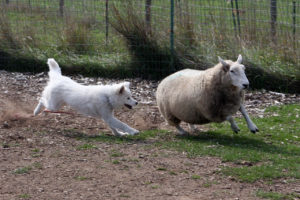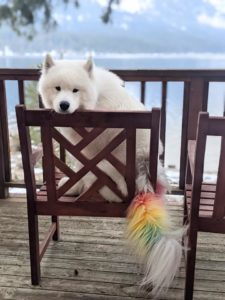Top Ten Pet Hazards In 2006
Top 10 Hazards Encountered by Pets in 2006
ASPCA Animal Poison Control Center’s list of top 10 hazards encountered by pets in 2006
reveals a significant increase in calls pertaining to common household items
Urbana, Ill., March 5, 2007—The ASPCA® (The American Society for the Prevention of Cruelty to Animals®) today announced that it managed more than 116,000 calls to its Animal Poison Control Center (APCC) hotline in 2006, several of which pertained to common household items. “While the reason is not clear, calls in virtually each of these categories seems to be on the rise,” said Dr. Steven Hansen, veterinary toxicologist and senior vice president with the ASPCA, who manages the ASPCA’s Midwest Office, which houses the APCC. As National Poison Prevention Week approaches (March 18-24), the ASPCA advises pet parents to stay alert to the possibility of poisoning from these common household items:
Human Medications: For several years now, this category has been number one on the ASPCA’s list of common hazards, and 2006 was no exception. Last year, more than 78,000 calls involving common human drugs such as painkillers, cold medications, antidepressants and dietary supplements were managed by the Center—a 69 percent increase over 2005. “Pet parents should never give their pet any medication without the direction of a veterinarian just one extra-strength acetaminophen can be deadly to a cat, and just four regular-strength ibuprofen can lead to serious kidney problems in a 10-pound dog,” says Dr. Hansen. To avoid inadvertent poisoning from medications, store them in a secure cabinet above the counter and out of the reach of pets.
Insecticides: The APCC handled more than 27,000 cases pertaining to products used to kill fleas, ticks and other insects in 2006, up more than 28 percent from 2005. According to Dr. Hansen, “A key factor in the safe use of products that eliminate fleas, ticks and other pesky bugs, is reading and following label instructions exactly. Some species of animals can be particularly sensitive to certain types of insecticides, so it is vital that you never use any product not specifically formulated for your pet.” It is also a good idea to consult with your pet’s veterinarian before beginning any flea and tick control program.
Veterinary Medications: Surprising as it may seem, last year the APCC managed more than 12,000 cases involving animal-related preparations such as non-steroidal anti-inflammatory drugs, heartworm preventatives, de-wormers, antibiotics, vaccines and nutritional supplements—a 93 percent hike in volume. “Although these products are formulated for use in pets, it is very important to always read and follow label directions for use exactly,” says Dr. Hansen. “As with flea and tick preparations, many medications are intended for use in certain species only, and potentially serious problems could result if given to the wrong animal or at too high a dose.”
Plants: The number of cases involving plants also shot up by more than 111 percent in 2006 to more than 9,300. Some varieties that can be harmful to pets include lilies, azalea, rhododendron, sago palm, kalanchoe and schefflera. ”Just one or two sago palm nuts can cause vomiting, diarrhea, depression, seizures and even liver failure,” says Dr. Hansen. “Also, lilies are highly toxic to cats—even in small amounts they can produce life-threatening kidney failure.” While poisonous plants should certainly be kept away from pets, it is also a good idea to discourage animals from nibbling on any variety of plant, as even non-toxic plants can lead to minor stomach upset.
Rodenticides: Last year, approximately 8,800 calls about rat and mouse poisons were received by the APCC, representing an increase of more than 27 percent over 2005. Depending on the type of rodenticide, ingestions can lead to potentially life-threatening problems for pets including bleeding, seizures or even damage to the kidneys or other vital organs. “Should pet owners opt to use a rodenticide around their home, they should make sure that the bait is placed only in areas completely inaccessible to their animals,” says Dr. Hansen.
Household Cleaners: In 2006, approximately 7,200 calls pertaining to cleaning agents such as bleaches, detergents and disinfectants were received—up 38 percent from the year before. Says Dr. Hansen, “Depending on the circumstances of exposure, some household cleaners can lead to gastrointestinal irritation or even severe oral burns for pets.” Additionally, irritation to the respiratory tract may be possible if a product is inhaled. “All household cleaners and other chemicals should be stored in a secure location well out of the reach of pets,” recommends Dr. Hansen, “and when cleaning your pet’s food and water bowls, crate or other habitat, a mild soap such as a hand dishwashing detergent along with hot water is a good choice over products containing potentially harsh chemicals.”
Chocolate: Always a common food-related call, more than 4,800 chocolate calls were received by the APCC last year, an 85 percent increase from 2005. Depending on the variety, chocolate can contain large amounts of fat and caffeine-like substances known as methylxanthines, which, if ingested in significant amounts, could potentially cause vomiting, diarrhea, panting, excessive thirst and urination, hyperactivity. In severe cases, abnormal heart rhythm, tremors and seizures have been noted—and it could even be fatal. “Typically, the darker the chocolate, the greater the potential for poisoning,” says Dr. Hansen. “Baking chocolate contains the highest amount of methylxanthines, and just two ounces could cause serious problems for a 10-pound dog.”
Chemical Hazards: A newcomer to the top 10 category, this includes such harmful items as volatile petroleum-based products, alcohols, acids, and gases. In 2006, the APCC received more than 4,100 calls related to chemical hazards—an astronomical jump in call volume of more than 300 percent. “Substances in this group can cause a wide variety of problems,” Dr. Hansen explains, “ranging from gastrointestinal upset and depression to respiratory difficulties and chemical burns.” Commonly-used chemicals you should keep your pets away from include ethylene glycol antifreeze, paint thinner, drain cleaners and pool/spa chemicals.
Physical Hazards: While not necessarily all toxic, items in this group consists of objects that could pose a choking hazard, risk for intestinal obstruction, or other physical injury, and in 2006, the number of physical hazard calls grew a staggering 460 percent to over 3,800 “We’ve managed cases involving the ingestion of several common objects—from pet collars and adhesive tape to bones, paper products and other similar items,” says Dr. Hansen. “It is important to make sure that items which could be easily knocked over, broken, chewed up or swallowed are kept out of the reach of curious pets.”
Home Improvement Products: In 2006, approximately 2,100 cases involving paint, solvents, expanding glues and other products commonly used in construction were managed by the APCC—up 17 percent from 2005. While the majority of water-based paints are low in toxic potential, they can still cause stomach upset, and artist paints sometimes contain heavy metals that could be poisonous if consumed in large quantities. In addition, solvents can be very irritating to the gastrointestinal tract, eyes and skin, and could also produce central nervous system depression if ingested, or pneumonia if inhaled. “Prevention is really key to avoiding problems from accidental exposures to these substances,” says Dr. Hansen. “Pet parents should keep pets out of areas where home improvement projects are taking place, and of course label directions should always be followed when using any product.”







